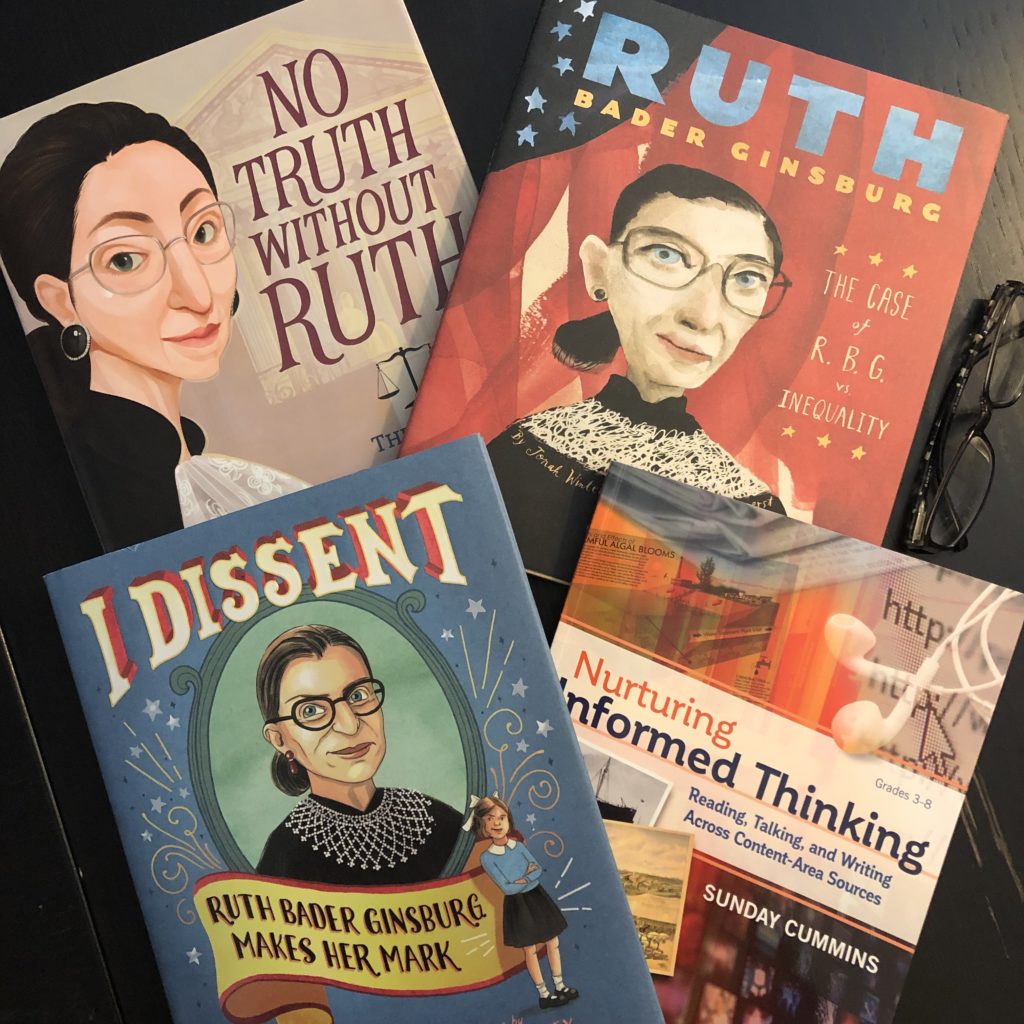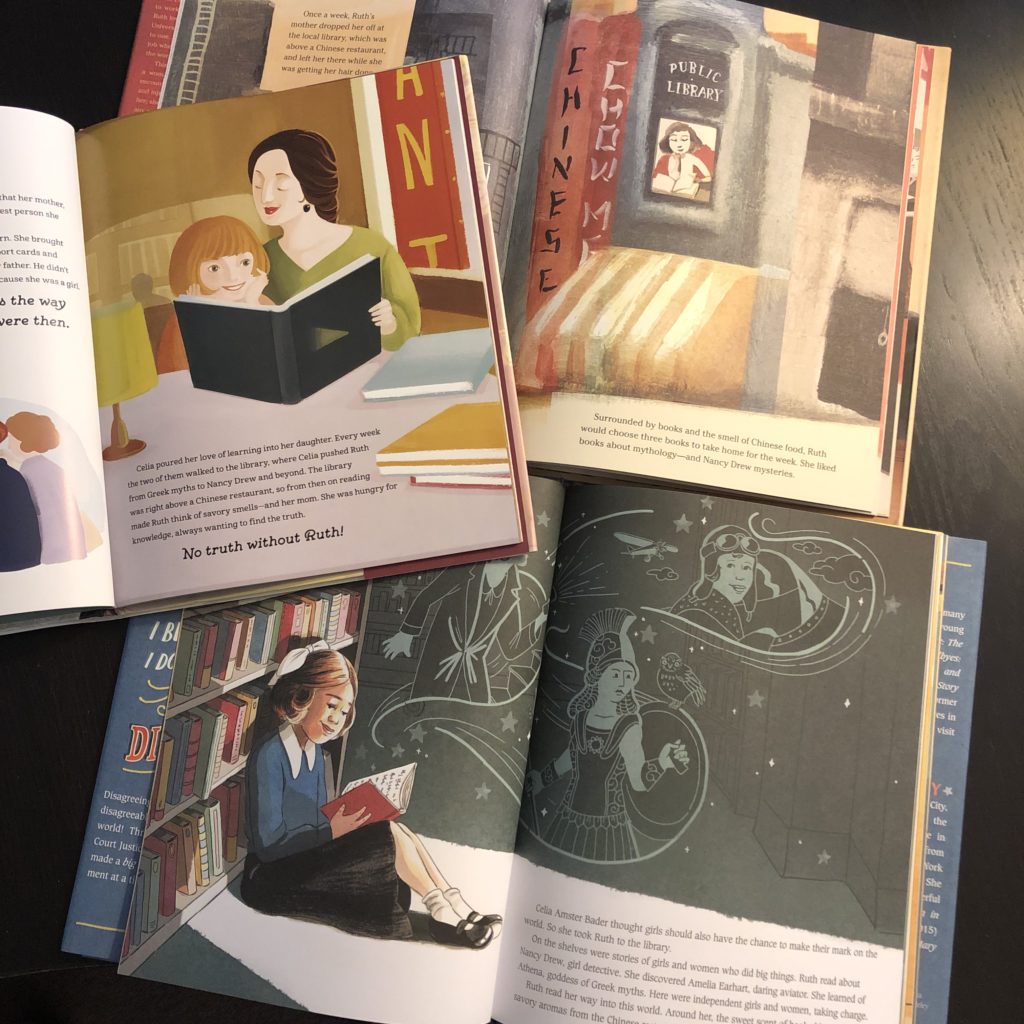Three books about Justice Ruth Bader Ginsburg.
Three different authors.
Each shape the facts to reveal distinct insight.

- I Dissent: Ruth Bader Ginsburg Makes Her Mark (Levy, 2016)
- Ruth Bader Ginsburg: The Case of R. B. G. vs. Inequality (Winter, 2017)
- No Truth Without Ruth: The Life of Ruth Bader Ginsburg (Krull, 2018)
Here are two examples of how the authors address the same part of Ginsburg’s life in different ways.
1. As a child, Ruth’s love of reading
- Winters shares the simple facts–she went to the public library often and checked out books on mythology and Nancy Drew Mysteries.
- Krull shares the same facts but she adds that Ruth “was hungry for knowledge, always wanting to find the truth” and includes the refrain “No truth without Ruth!”
- Levy takes this further and makes the case that Ginsburg read about “independent girls and women, taking charge” and points out that “Ruth read her way into this world…A girl could be anything.”

2. Ginsburg’s landmark case in front of the Supreme Court for equal rights
- Winters explains Ruth’s work for the ACLU’s Women’s Rights Project which included arguing and winning 5 out of 6 cases in front of the Supreme Court. He does not get into the specifics of the cases but instead states “She won the right for women to get “equal protection” of the laws–to be treated as equal to men.” (He builds up to this by revealing the injustices Ruth and women faced related to gender inequality.)
- Krull creates a picture for the reader of what it was like to argue a case in front of the Supreme Court. She goes into more detail about the first case Ginsburg argued in front of the Supreme Court – describing the Justices, Ginsburg “feeling queasy, her voice shaky,” a specific case (“an Idaho mother not allowed to take care of her dead son’s estate because she wasn’t a man”) Ruth brings up in her argument, then case itself. Krull also develops tension, Ruth’s building confidence, the Justice’s “stony silence” in response.
- Levy builds background knowledge about the Supreme Court’s support of a system that treated men and women differently and states “RUTH REALLY DISAGREED WITH THIS!” In Levy’s description of Ruth arguing in front of the Supreme Court for the first time, similar to Krull, Levy describes how nervous Ruth was. She also shares that Ruth would imagine herself as the professor she was for many years and would imagine that the Justices were her students. This image really helps the reader think about how Ruth calmed her nerves but also Ruth’s vision for how to win her cases – she needed to teach the Justices, to educate them.

THERE’S SO MUCH YOU COULD DO TO THINK CRITICALLY ACROSS THESE TEXTS. Krull uses the refrain “No truth without ruth” and Baddeley, the illustrator for Levy’s book, includes words like disagreed, protested, objected, persisted in bold capital lettering as part of the illustrations. How do both techniques reveal the author’s points of view or reveal a big idea in Ginsburg’s life story?
QUICK SUGGESTIONS FOR TEACHING –
- Interactive read aloud & close reading – Read aloud two of the titles and then project in some way the pages that address the same aspect of Ginsburg’s life. (Each of these books may take more than one period to read.) Pose open ended questions for discussion as a whole group or in student-led groups (and be prepared to THINK ALOUD if they hesitate) –
- How are the illustrations similar? Different?
- How are the facts similar and different?
- What did this author add that we didn’t read about in the first text?
- WHY READ BOTH??????
- Student-led reading, discussing, responding – Book talk the third title and leave out for independent or partner reading. Pose the following questions for discussion or written response:
- Remember how we discussed that one part of Justice Ginsburg’s life in the first two texts, what did you notice about that part in this third text?
- How are the facts similar and different?
- What did this author add that we didn’t read about in the first text?
- WHY READ ALL THREE??????
For suggestions with other sets of books, see these blog entries:


Hope this helps.
S
